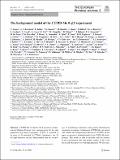The background model of the CUPID-Mo $$0\nu \beta \beta $$ 0 ν β β experiment
Author(s)
Augier, C.; Barabash, A. S.; Bellini, F.; Benato, G.; Beretta, M.; Bergé, L.; Billard, J.; Borovlev, Yu. A.; Cardani, L.; Casali, N.; Cazes, A.; Celi, E.; Chapellier, M.; Chiesa, D.; Dafinei, I.; Danevich, F. A.; De Jesus, M.; de Marcillac, P.; Dixon, T.; Dumoulin, L.; ... Show more Show less
Download10052_2023_Article_11830.pdf (2.223Mb)
Publisher with Creative Commons License
Publisher with Creative Commons License
Creative Commons Attribution
Terms of use
Metadata
Show full item recordAbstract
Abstract
CUPID-Mo, located in the Laboratoire Souterrain de Modane (France), was a demonstrator for the next generation
$$0\nu \beta \beta $$
0
ν
β
β
decay experiment, CUPID. It consisted of an array of 20 enriched Li
$$_{2}$$
2
$$^{100}$$
100
MoO
$$_4$$
4
bolometers and 20 Ge light detectors and has demonstrated that the technology of scintillating bolometers with particle identification capabilities is mature. Furthermore, CUPID-Mo can inform and validate the background prediction for CUPID. In this paper, we present a detailed model of the CUPID-Mo backgrounds. This model is able to describe well the features of the experimental data and enables studies of the
$$2\nu \beta \beta $$
2
ν
β
β
decay and other processes with high precision. We also measure the radio-purity of the Li
$$_{2}$$
2
$$^{100}$$
100
MoO
$$_4$$
4
crystals which are found to be sufficient for the CUPID goals. Finally, we also obtain a background index in the region of interest of 3.7
$$^{+0.9}_{-0.8}$$
-
0.8
+
0.9
(stat)
$$^{+1.5}_{-0.7}$$
-
0.7
+
1.5
(syst)
$$\times ~10 ^{-3}$$
×
10
-
3
counts/
$$\Delta E_{\text {FWHM}}/\text {mol}_{\text {iso}}/\text {year},$$
Δ
E
FWHM
/
mol
iso
/
year
,
the lowest in a bolometric
$$0\nu \beta \beta $$
0
ν
β
β
decay experiment.
Date issued
2023-07-28Department
Massachusetts Institute of Technology. Department of PhysicsPublisher
Springer Berlin Heidelberg
Citation
The European Physical Journal C. 2023 Jul 28;83(7):675
Version: Final published version